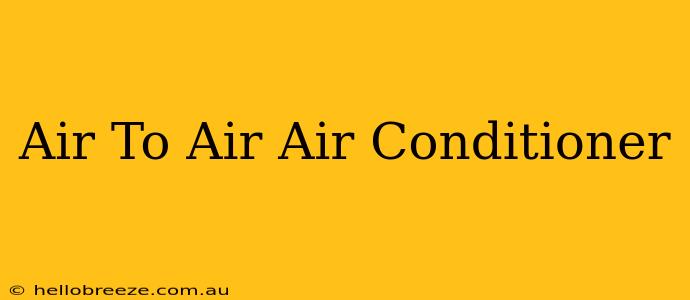Are you looking for an effective way to cool your home or office? Air-to-air air conditioners might be the perfect solution. This comprehensive guide will walk you through everything you need to know about these systems, helping you make an informed decision for your cooling needs.
Understanding Air-to-Air Air Conditioners
Air-to-air air conditioners, unlike other types of systems, transfer heat from one space to another, directly cooling one area while simultaneously warming another. This makes them a particularly energy-efficient option in certain situations. They're fundamentally different from traditional air conditioners that vent heat outside. Instead, they simply move the heat internally.
How They Work: The Basics
The process is relatively straightforward: A refrigerant absorbs heat from the area you want to cool (the "cold" side). This heat is then transferred to another area (the "hot" side), effectively warming it up. This closed-loop system means there's no heat loss to the outside environment.
Think of it like a sophisticated heat pump, just specifically designed for cooling one zone while heating another. This makes them ideal for situations where you need to manage temperature differences within a single building or space, minimizing energy waste.
Types of Air-to-Air Air Conditioners
While the core principle remains the same, several types of air-to-air air conditioners exist, each with its own advantages and disadvantages:
1. Split-System Air-to-Air Heat Pumps:
These are the most common type. They consist of two units: an indoor unit that cools and an outdoor unit that releases the absorbed heat. They're known for their efficiency and ability to provide both heating and cooling.
2. Packaged Air-to-Air Units:
These systems house both the cooling and heating components in a single unit, typically located in an attic or other out-of-the-way space. While less aesthetically pleasing than split systems, they're often simpler to install.
3. Window Air Conditioners (a Simple Form):
While not always explicitly labeled "air-to-air," a standard window unit essentially functions on this principle. It cools the room by transferring heat to the outside.
Advantages of Air-to-Air Air Conditioning
- Energy Efficiency: By transferring heat internally rather than expelling it outdoors, air-to-air systems can offer significant energy savings compared to traditional air conditioning, particularly in milder climates.
- Zoned Cooling: These systems allow for precise temperature control in specific areas, reducing energy waste associated with cooling unoccupied spaces.
- Heating and Cooling Capabilities: Many models provide both heating and cooling functionalities, simplifying your climate control needs.
- Reduced Environmental Impact: The improved energy efficiency translates to a smaller carbon footprint.
Disadvantages of Air-to-Air Air Conditioning
- Limited Applicability: They are most effective in situations where heating the "hot" side is desirable or doesn't negatively impact other areas.
- Installation Complexity: Some systems, particularly split-system units, can require professional installation.
- Potential for Uneven Temperatures: Improper installation or sizing can lead to uneven temperature distribution within the space.
- Higher Initial Cost (Sometimes): The initial investment can be higher compared to traditional window units, though the long-term savings on energy bills might offset this.
Choosing the Right Air-to-Air Air Conditioner
Selecting the best air-to-air air conditioner involves considering several factors:
- Size and Capacity (BTUs): The system's capacity must match the size of the space you intend to cool.
- Energy Efficiency Rating (SEER): Look for high SEER ratings to ensure energy efficiency.
- Installation Requirements: Consider whether you'll need professional installation.
- Budget: Balance the initial cost with potential long-term energy savings.
By carefully weighing the advantages, disadvantages, and specific needs of your space, you can find the perfect air-to-air air conditioner to create a comfortable and energy-efficient environment. Remember to consult with a qualified HVAC professional for guidance and installation.

